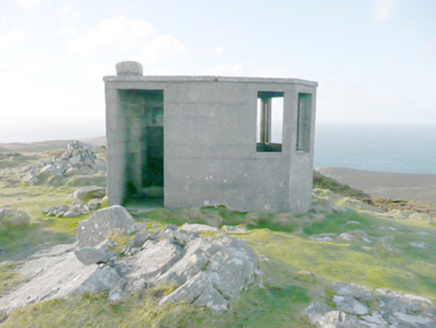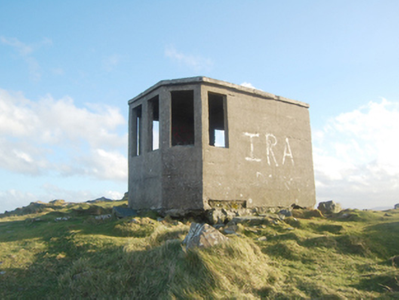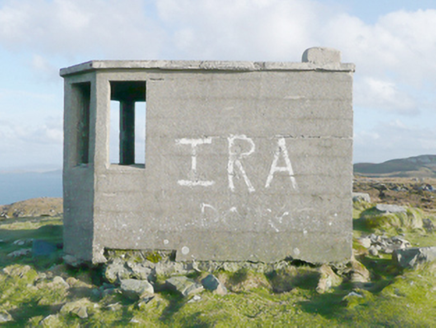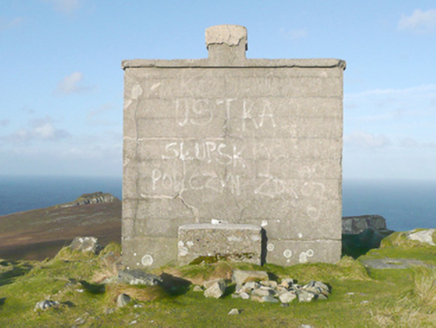Survey Data
Reg No
40901519
Rating
Regional
Categories of Special Interest
Architectural, Historical
Original Use
Signal tower
Date
1939 - 1945
Coordinates
201290, 440993
Date Recorded
17/11/2010
Date Updated
--/--/--
Description
Detached single-bay single-cell single-storey World War Two-era coastal watchman's hut\lookout post, in use c. 1939-45, having canted front elevation (north). Now out of use. Flat concrete roof with cement rendered chimneystack to the south end. Precast concrete walls having square-headed window openings, fittings now gone. Square-headed doorway to the east elevation, fittings now gone. Concrete fireplace to the south end of interior. Located in a prominent location on an elevated site on Coastguard Hill close to south of the tip of Horn Head, and to the north-west of Dunfanaghy. Built on the site of a former coastguard semaphore station, c. 1860. '77 Eire', c. 1940, sign painted on rocks at the tip of Horn Head to the north.
Appraisal
This unassuming former World War Two-era former watchman's\lookout hut is a structure of some historical interest in the scenic landscape to the north end of Horn Head. It was originally built by the Irish Army\Navy to monitor shipping, submarine, and aircraft activity in and over Irish waters during the Second World War, details of which was subsequently reported back to a military intelligence unit called ‘G2’. These posts were manned by soldiers and formed the ‘Coast Watching Service’. Ultimately, 83 posts were built between 1939 and 1942. Huts were constructed to an identical design from 137 pre-cast blocks. It was a considerable logistics exercise to establish these posts, and their construction was one of the most intensive engineering exercises undertaken by the Irish Defence Forces during the Second World War. It involved planning and constructing positions at strategic locations five to fifteen miles apart along a 1, 970 mile coastline from Ballagan Point in Louth to Inishowen Head in Donegal. Coastwatchers worked around the clock in groups of two in 8 or 12 hour shifts. One man remained inside the post operating the phone, the other patrolled outside. They had to report every military activity the observed in the sea and air in the vicinity of their LOP. Teams of 8 to 21 coast watchers worked on each Lookout Post. It is a simple structure, and was designed to provide basic comfort for the watchman\men on duty, having a fireplace to one wall. They were equipped with telephone, semaphore, and Morse code machines. The canted front provided an excellent view in three directions. It is one of a number of such surviving structures in County Donegal, and acts as a subtle historical reminder of this period in Irish history. At the request of the Allies, a large 'EIRE' and the number of the post (in this case 77) was marked beside them to warn their planes not to stray into neutral territory, which is still visible here at the tip of Horn Head to the north. Located in a dramatic coastal cliff views with panoramic views over Atlantic Ocean to the north, this structure is an integral element of the built heritage and maritime heritage of the local area. It is located close to the site of a former Napoleonic-era signal tower (see 40901510), now ruinous, and is built on the site of a later semaphore and\or telegraph station, which attests to a long running strategic interest in this location.







